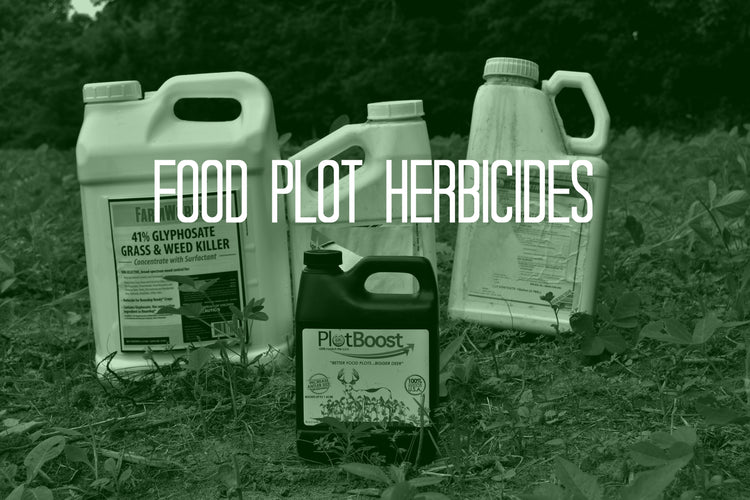Food Plot Herbicides and Weed Control Tips
Weeds are a big deal. Besides planning and establishing the plot, the most daunting task associated with food plots is weed control. Weeds can take root, out-compete, and even completely choke out your food plot. This begs the question, how do we, simple food plotters and hunters win the battle against weed control? While you don’t have to study up enough literature to become a bonafide farmer, knowing a couple food plot herbicides will be enough to keep your food plots in check!
Food Plot Herbicides
In order to achieve complete food plot weed control, there are 3 moments in a food plot’s life you need to take notice of. Contrary to common food plotter belief this starts well before even the first weed rears its ugly head out of the ground.Food Plot Herbicide Considerations
Moment #1: Before – before planting the plot, or even purchasing the seed you need to think about weed control. Mainly this comes down to asking yourself “how are you going to control weeds in this food plot?”. This question HAS GOT TO BE asked. This might prevent you from making a mistake and planting a mix of species without knowledge that a mix of species such as clover, oats, rape, and rye or wheat can virtually not be controlled using herbicides. Why? Every species you add to the mix narrows down which food plot herbicide you can or cannot use. This is critical, but general herbicide knowledge is key to even making these first initial decisions.
Moment #2: During – Actual spraying needs to come down to a science. In your head run through the checklist. Are you spraying enough herbicide? Are you spraying at the right time of the day? Do you have on PPE? Is drift a concern? Is your sprayer calibrated? Is your sprayer clean of any residual herbicides? Are you mixing in any additives?
Moment #3: After – An entirely new set of questions need to be asked after the spraying is done. How long does this herbicide take to see effects? Did you get 100% kill? Did you kill before the weeds reseeded themselves? Does it need a follow-up spray? Did any drift occur? Did you clean your tank? Food plotters also need to keep in mind these often forgotten questions…Did your food plot species survive? Is there any herbicide damage from spraying? Do you need to provide any fertilizer or applications to recover the plot? By simply reading the questions above you already are aware of some very prominent points of using herbicides on food plots. You are already making more informed decisions and are one step closer to establishing the skill of food plot weed control. Now you are ready to learn about the herbicides to use on food plots.
The Herbicides
There are essentially 3 food plot herbicides most plotters need to concern themselves with. The non-selective, the broadleaf selective, and the grass selective.Non-selective Herbicides
Round-up (Glyphosate) Non-selective herbicides essentially kill all herbicides, and these are relatively easy to understand as far as use. These are the most commonly used herbicides. Glyphosate or commonly known as Round-Up® is a post-emergent, non-selective herbicide that is most commonly used for site clearing and preparation. It is also used most commonly for weed control in Round-Up® ready soybeans and corn.
Grass Selective Herbicides
Poast, Select, Arrest, Vantage, Hi-Yield Grass Killer (Sethoxydim and Clethodim) In most food plots grasses are usually the most bothersome weeds you will encounter. Grasses have extensive root systems which make them great competitors for nutrients and water. The easiest and most effective method of grass control is to use a grass selective post-emergent foliar herbicide. The active ingredients in these types of herbicides are Sethoxydim and Clethodim. These are systematic herbicides meaning they move within the plant after application to the leaf structure. The common names you will find these herbicides under are Poast, Select, Arrest, and Vantage. These herbicides kill grasses but do not harm broadleaf species like clover, soybeans, peas, and brassicas. These types of herbicides will kill corn, wheat, oats, rye, and sorghum so keep this in mind, especially with mixed food plots. These herbicides often need to be coupled with crop oil or surfactant in order to penetrate leaf tissue. Results are not often seen until after 10 days.
Broadleaf Selective Weed Control
2,4-D, Butoxone 200, and Butyrac 200… 2-4-D (Dimethylamine Salt of 2, 4-Dichlorophenoxyacetic Acid) and 2-4-DB Amine, Pursuit/Slay (Imazethapyr) After grasses, pesky broadleaf species can and will wreak havoc on grass plots, and even out-compete some broadleaf plots. For this, there are two different application basis for broadleaf selective herbicides. One will kill most broadleaf species in grasses, the other will kill broadleaf species without affecting legumes. For Broadleaf weed control, 2,4-D and 2,4-DB (Butyrac) are commonly used. 2,4-D is commonly used in grass species food plots, such as corn, wheat, oats, and rye. 2,4-DB is significantly different in that it does not affect perennial legumes such as clover, alfalfa, and trefoil. Forage legumes and grasses are not sensitive to 2,4-DB but species such as chicory and brassicas are. The B is important! This is important to know when thinking of future weed control before planting a mix of species for your plot. Both herbicides work best when applied to smaller/younger weeds and have no significant soil active properties. Common symptoms on broad-leafed weeds after application will include stem twisting and Leaf strapping. Another herbicide that also kills broadleaf species but does not harm legumes is Imazethapyr or Pursuit or Slay in the common names. However, Imazethapyr is active in the ground and can affect other broadleaf species planted in the ground (like brassicas) up to 40 months after application. Be cautious of this!
Fighting Off Negative Herbicide Effects
A host of unintended herbicide effects can be witnessed after the fact on your food plot species. For example, 10 days after spraying both Clethodim and Butyrac 200 on a ladino white clover food plot, you see some of the clover leaves wilted and/or “burned up”. Herbicide damage does happen so it is important that you do what you can to manage it before your food plot is damaged too much. The most common form of herbicide damage we see is the “yellow flash” in soybeans food plots and corn food plots…this can often result in a yield drag of 5-10%! In soybeans, in particular, Glyphosate can actually suppress the formation of nitrogen nodules meaning a reduction in nitrogen and yield. While yield does not necessarily matter to food plotters as much as it would to farmers, an appropriate replacement for yield would be the attractiveness of the plot to deer. If your plot experiences herbicide damage, it will also most likely be experiencing a drop in nutrients, protein levels, and production…something deer definitely do select for.
By adding PlotBoost a proprietary blend that acts as a plant enhancer, directly in with the herbicide application (in the same tank) you can now fight off these negative herbicide effects. PlotBoost comes in a 32 oz bottle and is mixed directly in the tank with the herbicide on a 32 oz per acre basis. PlotBoost not only stops the perceived 5-10% yield drag but “boosts” the food plot species above and beyond not only the herbicide drag but conventional fertilizers. It does this by increasing not only the nutrient and water uptake and utilization in your plants but also the biological interactions in the plant and soil. PlotBoost is not simply a liquid fertilizer, rather it will:
- Improves plant growth and vigor
- Improves plant health
- Strengthens roots and stalks
- Counters negative effects of herbicides like glyphosate (RoundUp®)
- Supports sufficient water uptake and absorption
- Improves nutrient uptake and utilization
- Increases crop quality and yield
- Increases healthy indigenous microbial activity in the soil or growing medium
As food plots increasingly become a more important and prominent tool in the ever-expanding hunter’s toolbox, remember that without knowledge tools are useless. Without knowing what, why, and how to use herbicides, and how to counter some of the potential unintended side effects, food plots can literally be rendered useless. Study up on your herbicides, make smart decisions about the species you select and be ready to maintain and manage your food plots until the day you are ready to hunt them.


